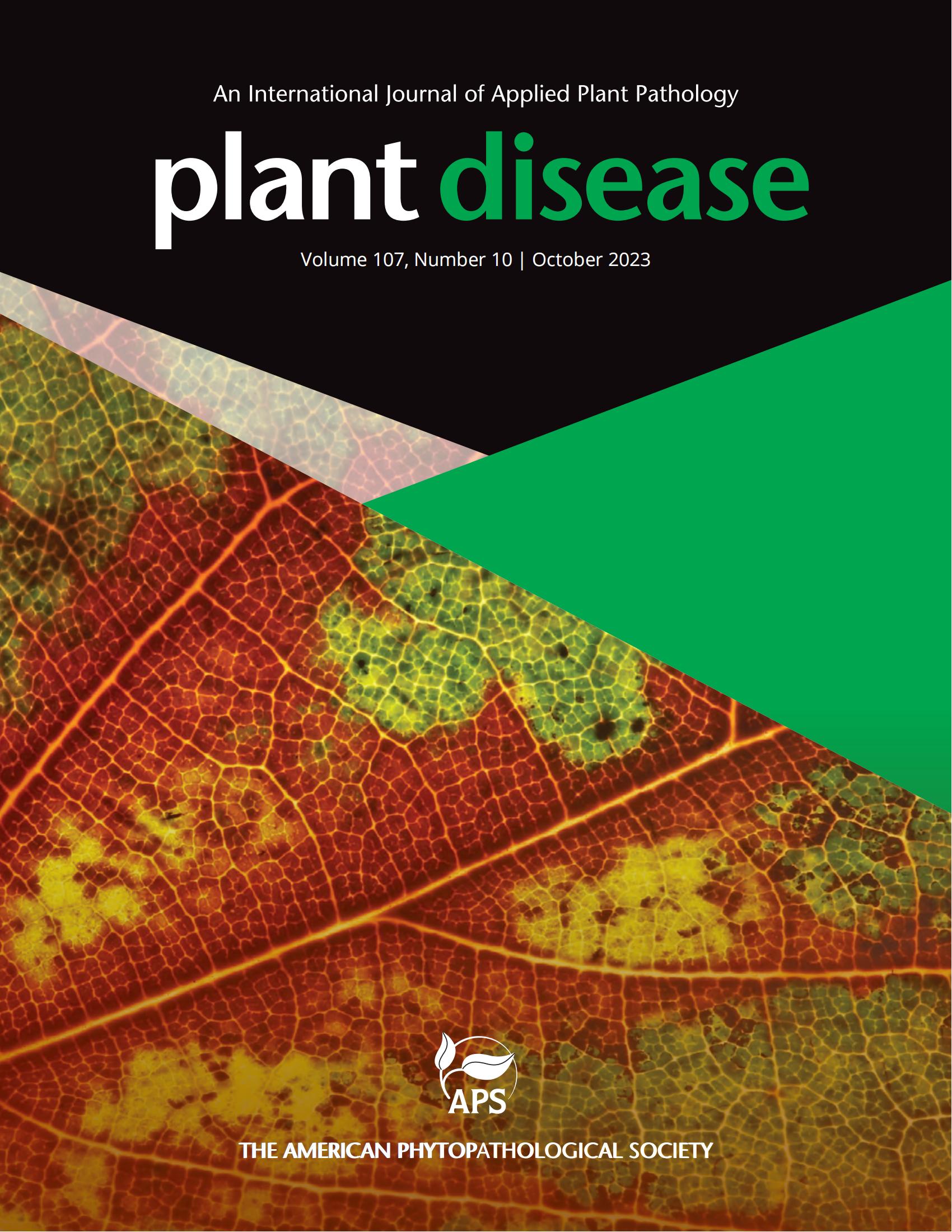中国首次报告 Cercospora chevalieri 在魔芋上引起叶斑病。
摘要
魔芋俗称 "巫毒百合",是中国西南地区广泛种植的经济作物(Gao 等,2022 年)。2022 年 8 月,位于中国云南富源(25.67°N; 104.25°E)的一块田(1 公顷)出现叶斑病症状,造成重大经济损失。褐斑病的发病率在 20% 至 40% 之间,病斑中心呈白色或灰色,周围有黄色晕圈。对病斑进行显微观察后发现,病菌为无形态的 Cercospora chevalieri。分生孢子梗为 50-150 × 4-7 μm,圆柱形,不分枝,壁光滑,淡褐色,聚集成密集的束状,生于褐色基质。分生孢子细胞呈整合状,顶生或闰生,淡褐色至褐色,交替增殖。分生孢子座增厚、变黑,直径 2-3 μm。分生孢子单个形成,倒棍棒状圆柱形, 90-160 × 5-7 μm,平均 130 × 6 μm(n = 30),6-11 个隔膜,薄壁,光滑,透明或近透明,直或弯曲,先端钝,基部钝截,种脐增厚且颜色变深。这些形态特征与 A. paeoniifolius 叶斑病的病原菌 C. chevalieri 相吻合(Braun 等,2014 年;Saccardo 等,1913 年)。病斑上的无菌水中的分生孢子悬浮液被用来接种水琼脂,发芽的分生孢子被转移到马铃薯葡萄糖琼脂(PDA)中,并在 27°C 下培养 7 天。使用 PDA 以及麦芽提取物琼脂、马铃薯蔗糖琼脂和合成贫养分琼脂诱导孢子都不成功。从十个分离株中选出两个进行分子鉴定和致病性检测。提取两个纯分离株(KUNCC22-12536 和 KUNCC22-12537)的基因组 DNA 进行 PCR 扩增,并使用内部转录间隔(ITS:ITS1/ITS4)、钙调素(CMD:CAL228F/CAL2Rd)、翻译延伸因子 1-α(TEF1-α:728F/986R)、肌动蛋白(ACT:512F/783R)、组蛋白 H3(HIS3:CYLH3F/CYLH3R)、β-微管蛋白基因(TUB2:BT-1F/BT-1R)和甘油醛-3-磷酸脱氢酶(GAPDH:Gpd1/Gpd2)(Vaghefi et al.2021).新生成的 C. chevalieri 的 ITS(OP719153/OP719154)、CMD(OP740904/OP740905)、TEF1-α(OP740910/OP740911)、ACT(OP740902/OP740903)、HIS3(OP740908/OP740909)、TUB2(OP740912/OP740913)、GAPDH(OP740906/OP740907)序列已提交至 Genetic Center。已提交至 GenBank。到目前为止,GenBank 数据库中还没有关于 C. chevalieri 的序列数据。不出所料,大多数基因(TEF1-α、ACT、CMD、HIS、TUB2 和 GAPDH)与 Cercospora 属物种内的最佳匹配基因有 91% 至 95% 的相同性。系统发生树显示,从魔芋叶斑中获得的两个分离物的序列聚集在一起,形成了一个强支持支系。为了验证科赫假说,在温室中使用了十株四个月大的健康魔芋盆栽进行致病性试验。每株植物的一片叶子接种菌丝体插穗,一片叶子接种无菌 PDA 插穗。只有接种了菌丝栓的叶片才会产生褐色病斑,病斑在接种叶片上出现 10 到 14 天后。用无菌 PDA 插条处理的对照植株仍无症状。该实验重复了两次,结果相同。根据形态学和 ITS 区域的 Sanger 测序,从受感染的叶片中重新分离出了 C. chevalieri。据我们所知,这是第一份关于 C. chevalieri 导致魔芋叶斑病的报告,也是中国关于该物种的第一份报告(Braun 等,2014 年),这为该疾病的诊断和管理提供了关键信息。Amorphophallus konjac, commonly called voodoo lily, is a cash crop widely cultivated in southwest China (Gao et al. 2022). In August 2022, leaf spot symptoms were observed in a field (1 ha) located at Fuyuan (25.67°N; 104.25°E), Yunnan, China, resulting in substantial economic losses. Brown lesions, with an incidence ranging from 20 to 40%, typically had a whitish or gray center and were surrounded by yellow halos. Microscopic observations of the spots revealed anamorphic species Cercospora chevalieri. Conidiophores were 50-150 × 4-7 μm, cylindrical, unbranched, smooth-walled, pale brown and aggregated in dense fascicles arising from a brown stroma. The conidiogenous cells were integrated, terminal or intercalary, pale brown to brown and proliferated sympodially. The conidiogenous loci were thickened and darkened, and 2-3 μm in diam. The conidia were formed singly, obclavate-cylindrical, 90-160 × 5-7 μm, with an average of 130 × 6 μm (n = 30), 6-11 septa, thin-walled, smooth, hyaline or subhyaline, straight or curved with an obtuse apex and obconically truncate base, with thickened and darkened hilum. These morphological characteristics matched those of C. chevalieri, the causal agent of leaf spot on A. paeoniifolius (Braun et al. 2014; Saccardo et al. 1913). A conidial suspension in sterile water from lesions was used to inoculate water agar, and germinated conidia were transferred to potato dextrose agar(PDA) and incubated at 27°C for 7 days. Induction of sporulation was unsuccessful using PDA, as well as malt extract agar, potato sucrose agar and synthetic nutrient-poor agar. Two out of ten isolates were selected for molecular identification and pathogenicity assay. Genomic DNA from two pure isolates (KUNCC22-12536 and KUNCC22-12537) was extracted for PCR and amplified with primers for the internal transcribed spacers (ITS: ITS1/ITS4), calmodulin (CMD: CAL228F/CAL2Rd), translation elongation factor 1-alpha (TEF1-α: 728F/986R), actin (ACT: 512F/783R), histone H3 (HIS3: CYLH3F/CYLH3R), beta-tubulin gene (TUB2: BT-1F/BT-1R) and glyceraldehyde-3-phosphate dehydrogenase (GAPDH: Gpd1/Gpd2), respectively (Vaghefi et al. 2021). The newly generated sequences for ITS (OP719153/OP719154), CMD(OP740904/OP740905), TEF1-α (OP740910/OP740911), ACT (OP740902/OP740903), HIS3 (OP740908/OP740909), TUB2 (OP740912/OP740913), GAPDH (OP740906/OP740907) of C. chevalieri were submitted to GenBank. So far, no sequence data of C. chevalieri were available in the GenBank database. As expected, most genes (TEF1-α, ACT, CMD, HIS, TUB2 and GAPDH) showed 91 to 95% identity to their best hits within species of the genus Cercospora. The phylogenetic tree showed that sequences retrieved from two isolates obtained from the A. konjac leaf spots clustered together within Cercospora forming a strongly supported clade. To test Koch's postulates, ten four-month-old healthy A. konjac plants grown in pots were used for a pathogenicity test in a greenhouse. One leaf of each plant was inoculated with mycelial plugs, and one leaf was inoculated with a sterile PDA plug. These plants were enclosed in plastic bags for 72 h. Only leaves inoculated with mycelium plugs produced brown lesions, which appeared after 10 to 14 days on inoculated leaves. Control plants treated with sterile PDA plugs remained asymptomatic. This experiment was repeated twice with the same results. C. chevalieri was reisolated from infected leaves and identified based on morphology and Sanger sequencing of the ITS region. To our knowledge, this is the first report of C. chevalieri causing leaf spot on A. konjac and the first report of this species from China (Braun et al. 2014), which provides key information for diagnosis and management of this disease.

 求助内容:
求助内容: 应助结果提醒方式:
应助结果提醒方式:


